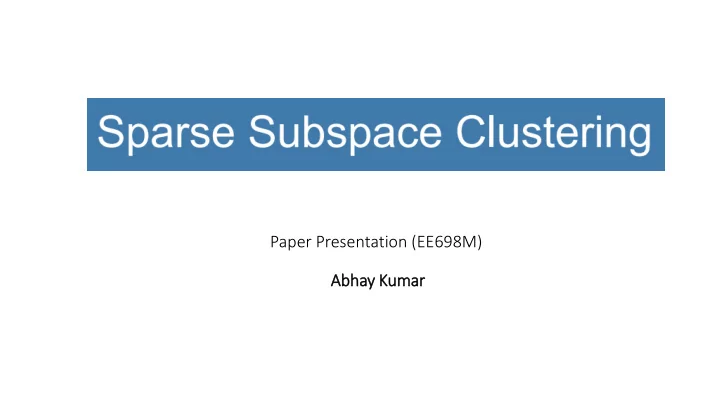

Paper Presentation (EE698M) Abhay Kumar
Subspace clustering • Cluster data drawn from multiple low-dimensional linear or affine subspaces embedded in a high-dimensional space
Subspace clustering : Purpose • Separate data into subspaces • Find low-dimensional representations
Various Methodology: • K-subspaces • Assigns points to subspaces Fit subspace to each cluster Iterate • Drawback: Requires Number and dimensions of subspaces to be known • Statistical approaches such as Mixture of Probabilistic PCA , Multi-stage Learning • Assuming each subspace has Gaussian distribution subspace estimation by EM • Drawback: Requires Number and dimensions of subspaces to be known • Factorisation based methods • low-rank factorization of the data matrix • segmentation by thresholding the entries of a similarity matrix • Generalized Principal Component Analysis ( GPCA ) • fit the data with a polynomial whose gradient at a point gives a vector normal to the subspace containing that point • Information theoretic approaches, such as Agglomerative Lossy Compression ( ALC ) • Model each subspace as degenerate Gaussian segment data so as to minimise the coding length needed to fit these points with the mixture of Gaussians
Challenges: • Intersecting subspaces • noise, outliers, missing entries • Computational complexity: NP hard (non-deterministic polynomial- time) • Knowledge of dimension/number of subspaces
Sparse representation in a single subspace • Sparse representation in a single subspace where • In many cases can have a sparse representation in a properly chosen basis Ψ. • we do not measure directly. Instead, we measure m linear combinations of entries of of the form • where is called the measurement matrix. • one can recover K-sparse signals/vectors if • Optimisation problem:
Sparse representation in a union of subspaces • Let : set of bases for n disjoint linear subspaces • • What if y belong to i-th subspace ?? • Optimisation Problems:-
Clustering linear subspaces: • Known: • Sparsifying basis for the union of subspaces given by the data matrix • Unknown: • not have any basis for any of the subspaces • don’t know which data belong to which subspace • d on’t know total number of subspaces
Subspace clustering • Assume: • : n-independent linear subspaces (unknown ) • : N data points collected from union of subspaces (known ) • : unknown dimensions of n-subspaces. • : unknown bases for n-subspaces. • Represent data matrix as where ; and is unknown permutation matrix that specifies the segmentation of data
Subspace clustering • Let where • If a point is a new data point in ?? • Optimisation problem:
Subspace clustering • Let be the matrix obtained from by removing • The optimal solution has non-zero entries corresponding to the columns in that lie in the same subspace as • Insert zero at i-th row of to make it N-dimensional • Solve for each point • Finally obtained a matrix of coefficients
Subspace clustering
Subspace clustering • All vertices representing data points in the same subspace form a connected component in the graph G = (V,E) where vertices V are the N data points and there is an edge when • In case of n-subspaces • where
Subspace clustering • Laplacian matrix of • Result from graph theory:- • Segmentation of data by applying k-means to a subset of eigenvectors of the Laplacian
Subspace clustering
Subspace clustering • Similar extension for affine subspaces • For noisy data (noise level bounded by ) :- • For noisy data (noise level unknown) • For missing or corrupted data • Very similar approach as “ Inpainting ”
Results: motion segmentation • motion segmentation problem, we consider the Hopkins 155 dataset, which consists of 155 video sequences of 2 or 3 motions corresponding to 2 or 3 low-dimensional subspaces in each video
Results: face clustering • Ext YaleB faces
Sparse Subspace clustering: Claims • Global sparse optimization • Can deal with data points near the intersections • Can deal with noise, outlying / missing entries • Don’t require dimension / number of subspaces Achieves/outperforms state-of-the-art results in • segmentation of rigid-body motions • clustering of face images • temporal segmentation of videos
References 1. E. Elhamifar and R. Vidal, "Sparse subspace clustering," Computer Vision and Pattern Recognition, 2009. CVPR 2009. IEEE Conference on , Miami, FL, 2009, pp. 2790-2797. doi: 10.1109/CVPR.2009.5206547 2. E. Elhamifar and R. Vidal, "Sparse Subspace Clustering: Algorithm, Theory, and Applications," in IEEE Transactions on Pattern Analysis and Machine Intelligence , vol. 35, no. 11, pp. 2765-2781, Nov. 2013. doi: 10.1109/TPAMI.2013.57 3. http://www.ccs.neu.edu/home/eelhami/cvpr15tutorial_files/Elhamifar_presentation_ cvpr15.pdf 4. http://cis.jhu.edu/~rvidal/publications/SPM-Tutorial-Final.pdf 5. http://www.math.umn.edu/~lerman/Meetings/SIAM12_Ehsan.pdf 6. http://arxiv.org/pdf/1203.1005.pdf
Recommend
More recommend